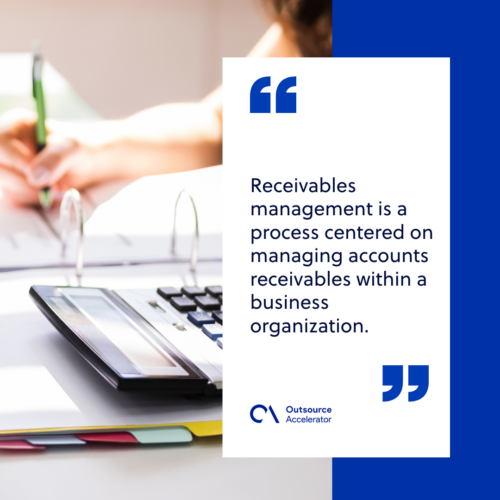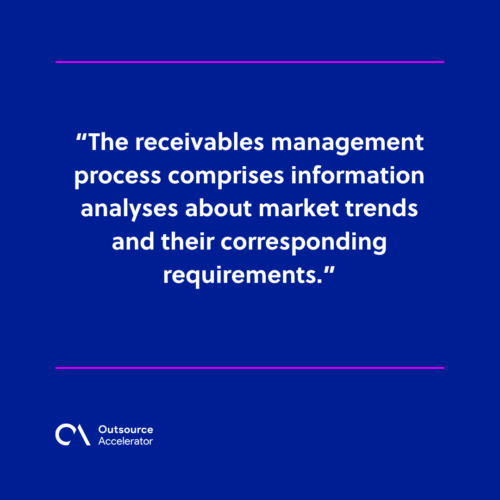Receivables management: Definition, objectives, and benefits

Record keeping and proper monitoring of financial transactions can be challenging but are very important in ensuring a sound operation for any business.
In addition to the usual tracking of income and expenses, top management must have a clear projection of the company’s cash flow. This vitality has led many businesses to establish strong accounting and bookkeeping strategies.
Receivables management is one of these strategies where the presence of dedicated personnel who are kin to details is a primary requirement.
Due to its importance for business transactions to work accurately, many organizations are taking it as a top priority in operational development.
This article explains all about receivables management, its definition, objective, and benefits.
What is receivables management?
Receivables management is a process centered on managing accounts receivables within a business organization. It keeps records of what customers buy on credit from a company.
A receivable is a term used to define the quantity of unreceived payment, anchoring the accounts receivables. It refers to the amount customers have not paid and is treated as liquid assets.
Accounts receivable management can be tedious, particularly for large-scale organizations with satellite offices. Some companies consider outsourcing accounting staff for excellent service.
Clark Staff offers reliable solutions for outsourced accounting services. They are known to provide accounting experts who can handle various tasks efficiently, including AR management.
In the recent forecast from Statista, the revenue of accounting, bookkeeping, and auditing activities in the United Kingdom reach up to 39.45 billion USD by 2025.

Receivables management objectives
Receivables management has a broad scope depending on the business’s requirements. However, its objectives focus on establishing and organizing the systems and financial transaction processes.
Here are the primary objectives in performing receivables management:
Monitor cash flow to minimize bad debts
Receivables management helps businesses maintain a systematic record of all financial transactions. For one, it helps leaders decide if investing in trade debtors is still manageable based on how much credit they have.
Without proper monitoring, bad debts correspond to extensive company losses. Receivables management ensures that the company takes all the necessary actions to avoid bad debts.
It establishes timelines and schedules for collection, helping customers pay on time and preventing them from paying accrued changes and interest for delayed payments.
2. Avoid transaction disputes and maintain good partnership
Receivables management also avoids disputes between the business and customers by providing complete records of daily transactions.
It eliminates the challenge of confusion because accurate and reliable records are maintained. Most businesses today also invest in automating receivables management to streamline and easily present transaction records in just a few clicks.
3. Optimize investments in receivables
Receivables management helps balance profit and risk in the business. Providing credit channels to customers is good, but marginal costs and profits should be equal.
Contributory factors, such as economic conditions and competition rate, are controllable with the help of good receivables management. The credit terms and conditions guide customers in collection procedures.
Benefits of effective receivables management in the business
With the objectives provided, businesses can maximize the benefits of receivables management. It usually aligns with productivity and good service delivery.
Here are the following benefits of effective receivables management in your business:
Enhances customer satisfaction
Any innovative actions of an organization directly contribute to overall customer satisfaction. It is vital because customer satisfaction is the primary element for good business relationships.
Through different lending channels, companies can support their customers who currently have limitations in purchasing products or services on a full cash basis.
Receivables management assists in designing better credit terms and facilities where partners can choose depending on their capabilities.
Improves sales and profit generation
Receivables from unpaid transactions are still part of a competitive sales generation. Effective receivables management improves not just the sales but also the company’s relationship with consumers.
The comprehensive credit terms and conditions will secure the sales profit of the company until the debtor can settle and complete payment balances.
Helps administer the market competition
There is a high demand for efforts in the global market competition today. The receivables management process comprises information analyses about market trends and their corresponding requirements.
It assists businesses in farming appropriate lending policies based on the existing market offers. Rates of credit services are adjusted accordingly by companies based on their customers’ needs.

Advances payment performance of customers
Paying credit services is a customer’s responsibility. However, automating timelines and schedules of payments will also help the organization and its customers monitor transactions.
Many companies have recorded significant improvements in collecting receivables after utilizing receivables management in their payment process.
Its capability to remind and communicate customers’ dues eliminates risks of collection delays and waives all penalty charges that may apply.
Shaping future business development through receivables management
The primary requirement for business development is for the organization to meet the resources needed to continue its operations. With receivables management, companies today widen their reach to cater to more customers.
Although credit transactions are risky, receivables management drives many companies to pursue partnerships because its monitoring capability enhances security in collection.
With this function becoming more common in outsourcing, receivable automation is also being examined as a method to expedite the process.
The connection between businesses and their customers as partners, backed by receivables management, shapes and strengthens the future of business development.
This applies particularly to small-scale companies that aim for expansion but have limited resources.







 Independent
Independent




